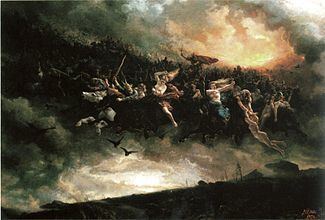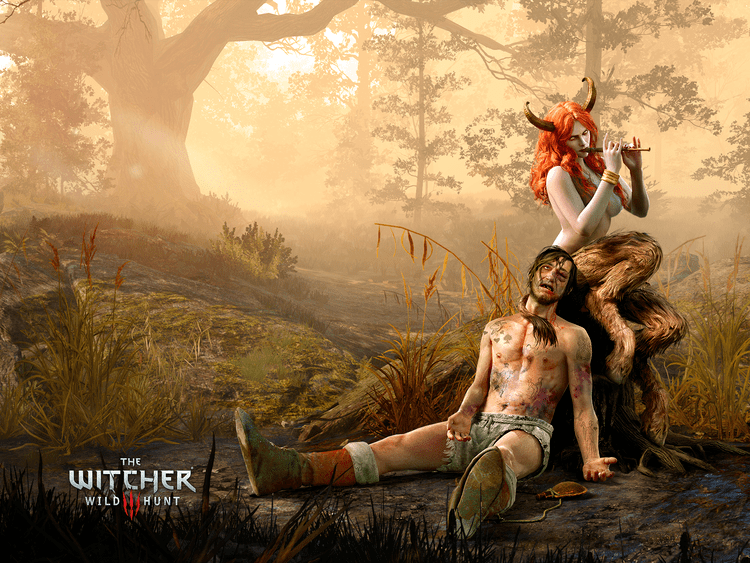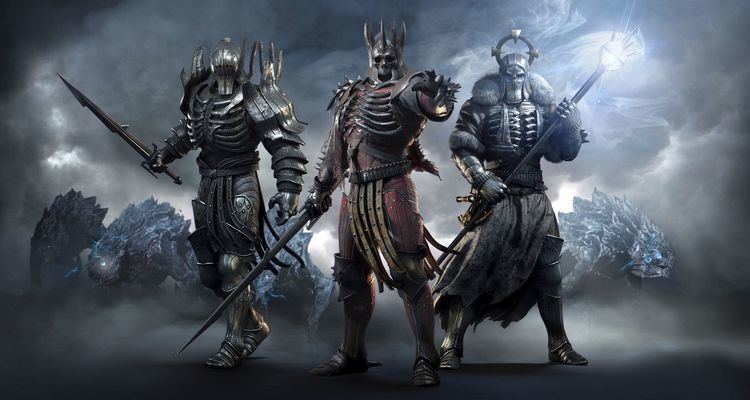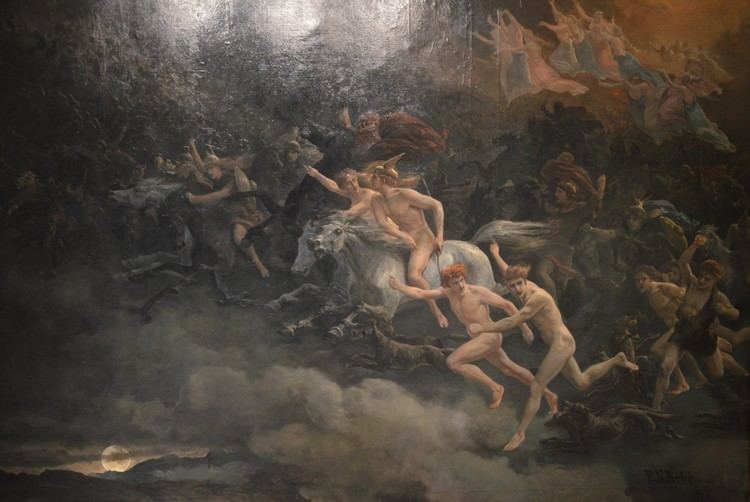 | ||
a night to remember launch cinematic the witcher iii wild hunt
The Wild Hunt is a European folk myth involving a ghostly or supernatural group of huntsmen passing in wild pursuit. The hunters may be either elves or fairies or the dead, and the leader of the hunt is often a named figure associated with Woden (or other reflections of the same god, such as Alemannic Wuodan in Wuotis Heer ("Wuodan's Army") of Central Switzerland, Swabia etc.), but may variously be a historical or legendary figure like Theodoric the Great, the Danish king Valdemar Atterdag, the Welsh psychopomp Gwyn ap Nudd, biblical figures such as Herod, Cain, Gabriel or the Devil, or an unidentified lost soul or spirit either male or female.
Contents
- a night to remember launch cinematic the witcher iii wild hunt
- The witcher 3 wild hunt final boss fight eredin boss fight
- Comparative evidence and terminology
- History
- Britain
- Germany
- Scandinavia
- Leader of the Wild Hunt
- In modern Paganism
- References

Seeing the Wild Hunt was thought to presage some catastrophe such as war or plague, or at best the death of the one who witnessed it. People encountering the Hunt might also be abducted to the underworld or the fairy kingdom. In some instances, it was also believed that people's spirits could be pulled away during their sleep to join the cavalcade.

The concept was developed based on comparative mythology by Jacob Grimm in Deutsche Mythologie (1835) as a folkloristic survival of Germanic pagan tradition, but comparable folk myths are found throughout Northern, Western and Central Europe. Grimm popularised the term Wilde Jagd ("Wild Hunt") for the phenomenon.

The witcher 3 wild hunt final boss fight eredin boss fight
Comparative evidence and terminology

Based on the comparative approach based on German folklore, the phenomenon is often referred to as Wilde Jagd (German: "wild hunt/chase") or Wildes Heer (German: "wild host"). In Germany, where it was also known as the "Wild Army", or "Furious Army", its leader was given various identities, including Wodan (or "Woden"), Knecht Ruprecht (cf. Krampus), Berchtold (or Berchta), and Holda (or "Holle"). The Wild Hunt is also known from post-medieval folklore.
In England, it was known as Herlaþing (Old English: "Herla's assembly"), Woden's Hunt, Herod's Hunt, Cain's Hunt, the Devil's Dandy Dogs (in Cornwall), Gabriel's Hounds (in northern England), and Ghost Riders (in North America). In Wales, a comparable folk myth is known as Cŵn Annwn (Welsh: "hounds of Annwn").
In Scandinavia, the Wild Hunt is known as Oskoreia or Asgårdsreia (originally oskurreia) (Norwegian: "noisy riders", "The Ride of Asgard"), and Odens jakt or Vilda jakten (Swedish: "the hunt of Odin" or "wild hunt").
In France, it was known as Mesnée d'Hellequin (Old North French: "household of Hellequin"); in Canada it becomes Chasse-galerie. In West Slavic Central Europe it is known as divoký hon or štvaní (Czech: "wild hunt", "baiting"), Dziki Gon or Dziki Łów (Polish), and Divja Jaga (Slovene: "the wild hunting party" or "wild hunt"). Other variations of the same folk myth are Caccia Morta (Dead hunt) or Caccia selvaggia (wild hunt) in Italy; Estantiga (from Hoste Antiga, Galician: "the old army"), Hostia, Compaña and Santa Compaña ("troop, company") in Galicia; Güestia in Asturias; Hueste de Ánimas ("troop of ghosts") in León; and Hueste de Guerra ("war company") or Cortejo de Gente de Muerte ("deadly retinue") in Extremadura.
History
The concept of the Wild Hunt was first documented by the German folklorist Jacob Grimm, who first published it in his 1835 book Deutsche Mythologie. It was in this work that he popularised the term Wilde Jagd ("Wild Hunt") for the phenomenon. Grimm's methodological approach was rooted in the idea – common in nineteenth-century Europe – that modern folklore represented a fossilized survival of the beliefs of the distant past. In developing his idea of the Wild Hunt, he mixed together recent folkloric sources with textual evidence dating to the Medieval and Early Modern periods. This approach came to be criticized within the field of folkloristics during the 20th century, as more emphasis was placed on the "dynamic and evolving nature of folklore".
Grimm interpreted the Wild Hunt phenomenon as having pre-Christian origins, arguing that the male figure who appeared in it was a survival of folk beliefs about the god Wodan, who had "lost his sociable character, his near familiar features, and assumed the aspect of a dark and dreadful power... a spectre and a devil." Grimm believed that this male figure was sometimes replaced by a female counterpart, whom he referred to as Holda and Berchta. In his words, "not only Wuotan and other gods, but heathen goddesses too, may head the furious host: the wild hunter passes into the wood-wife, Wôden into frau Gaude." He added his opinion that this female figure was Woden's wife.
Discussing martial elements of the Wild Hunt, Grimm commented that "it marches as an army, it portends the outbreak of war." He added that a number of figures that had been recorded as leading the hunt, such as "Wuotan, Huckelbernd, Berholt, bestriding their white war-horse, armed and spurred, appear still as supreme directors of the war for which they, so to speak, give licence to mankind."
Grimm believed that in pre-Christian Europe, the hunt, led by a god and a goddess, either visited "the land at some holy tide, bringing welfare and blessing, accepting gifts and offerings of the people" or they alternately float "unseen through the air, perceptible in cloudy shapes, in the roar and howl of the winds, carrying on war, hunting or the game of ninepins, the chief employments of ancient heroes: an array which, less tied down to a definite time, explains more the natural phenomenon." He believed that under the influence of Christianisation, the story was converted from being that of a "solemn march of gods" to being "a pack of horrid spectres, dashed with dark and devilish ingredients".
Hans Peter Duerr (1985) noted that for modern readers, it "is generally difficult to decide, on the basis of the sources, whether what is involved in the reports about the appearance of the Wild Hunt is merely a demonic interpretation of natural phenomenon, or whether we are dealing with a description of ritual processions of humans changed into demons." Historian Ronald Hutton noted that there was "a powerful and well-established international scholarly tradition" which argued that the Medieval Wild Hunt legends were an influence on the development of the Early Modern ideas of the Witches' Sabbath. Hutton nevertheless believed that this approach could be "fundamentally challenged".
Britain
In England, the historical figures St. Guthlac (683–714) and Hereward the Wake (died ca. 1070) were reported to have participated in the Wild Hunt; and, in the Peterborough Chronicle, there is an account of the Wild Hunt's appearance at night, beginning with the appointment of a disastrous abbot for the monastery, Henry d'Angely, in 1127:
Many men both saw and heard a great number of huntsmen hunting. The huntsmen were black, huge, and hideous, and rode on black horses and on black he-goats, and their hounds were jet black, with eyes like saucers, and horrible. This was seen in the very deer park of the town of Peterborough, and in all the woods that stretch from that same town to Stamford, and in the night the monks heard them sounding and winding their horns.
Reliable witnesses were said to have given the number of huntsmen as twenty or thirty, and it is said, in effect, that this went on for nine weeks, ending at Easter. Orderic Vitalis (1075–c. 1142), an English monk cloistered at St Evroul-en-Ouche, in Normandy, reported a similar cavalcade seen in January 1091, which he said were "Herlechin's troop" (familia Herlechini; cf. Harlequin).
While these earlier reports of Wild Hunts were recorded by clerics and portrayed as diabolic, in late medieval romances, such as Sir Orfeo, the hunters are rather from a faery otherworld, where the Wild Hunt was the hosting of the fairies; its leaders also varied, but they included Gwydion, Gwynn ap Nudd, King Arthur, Nuada, King Herla, Woden, the Devil and Herne the Hunter. Many legends are told of their origins, as in that of "Dando and his dogs" or "the dandy dogs": Dando, wanting a drink but having exhausted what his huntsmen carried, declared he would go to hell for it. A stranger came and offered a drink, only to steal Dando's game and then Dando himself, with his dogs giving chase. The sight was long claimed to have been seen in the area. Another legend recounted how King Herla, having visited the Fairy King, was warned not to step down from his horse until the greyhound he carried jumped down; he found that three centuries had passed during his visit, and those of his men who dismounted crumbled to dust; he and his men are still riding, because the greyhound has yet to jump down.
The myth of the Wild Hunt has through the ages been modified to accommodate other gods and folk heroes, among them King Arthur and, more recently, in a Dartmoor folk legend, Sir Francis Drake. At Cadbury Castle in Somerset an old lane near the castle was called King Arthur's Lane and even in the 19th century the idea survived that on wild winter nights the king and his hounds could be heard rushing along it.
In certain parts of Britain, the hunt is said to be that of hell-hounds chasing sinners or the unbaptised. In Devon these are known as Yeth (Heath) or Wisht Hounds, in Cornwall Dando and his Dogs or the Devil and his Dandy Dogs, in Wales the Cwn Annwn, the Hounds of Hell, and in Somerset as Gabriel Ratchets or Retchets (dogs). In Devon the hunt is particularly associated with Wistman's Wood.
Germany
An abundance of different tales of the Wild Hunt are recorded in Germany. In most tales, the identity of the hunter is not made clear, in others, it is:
Sometimes, the tales associate the hunter with a dragon or the devil. The hunter is most often riding a horse, seldom a horse-drawn carriage, and usually has several hounds in his company. If the prey is mentioned, it is most often a young woman, either guilty or innocent. The majority of the tales deal with some person encountering the Wild Hunt. If this person stands up against the hunters, he will be punished. If he helps the hunt, he will be awarded money, gold or, most often, a leg of a slain animal or human, which is often cursed in a way that makes it impossible to be rid of it. In this case, the person has to find a priest or magician able to ban it, or trick the Wild Hunt into taking the leg back by asking for salt, which the hunt can not deliver. In many versions, a person staying right in the middle of the road during the encounter is safe.
Scandinavia
In Scandinavia, Odin's hunt was heard but rarely seen, and a typical trait is that one of Odin's dogs was barking louder and a second one fainter. Beside one or two shots, these barks were the only sounds that were clearly identified. When Odin's hunt was heard, it meant changing weather in many regions, but it could also mean war and unrest. According to some reports, the forest turned silent and only a whining sound and dog barks could be heard.
In western Sweden and sometimes in the east as well, it has been said that Odin was a nobleman or even a king who had hunted during the Sundays and therefore was doomed to hunt down and kill supernatural beings until the end of time. According to certain accounts, Odin does not ride, but travels in a wheeled vehicle, specifically a one-wheeled cart.
In parts of Småland, it appears that people believed that Odin hunted with large birds when the dogs got tired. When it was needed, he could transform a bevy of sparrows into an armed host.
If houses were built on former roads, they could be burnt down, because Odin did not change his plans if he had formerly travelled on a road there. Not even charcoal kilns could be built on disused roads, because if Odin was hunting the kiln would be ablaze.
One tradition maintains that Odin did not travel further up than an ox wears his yoke, so if Odin was hunting, it was safest to throw oneself onto the ground in order to avoid being hit, a pourquoi story that evolved as an explanation for the popular belief that persons lying at ground level are safer from lightning strikes than are persons who are standing. In Älghult in Småland, it was safest to carry a piece of bread and a piece of steel when going to church and back during Yule. The reason was that if one met the rider with the broad-rimmed hat, one should throw the piece of steel in front of oneself, but if one met his dogs first, one should throw the pieces of bread instead.
Leader of the Wild Hunt
In modern Paganism
Various practitioners of the contemporary Pagan religion of Wicca have drawn upon folklore involving the Wild Hunt to inspire their own rites. In their context, the leader of the Wild Hunt is the goddess Hecate. The anthropologist Susan Greenwood provided an account of one such Wild Hunt ritual performed by a modern Pagan group in Norfolk during the late 1990s, stating that they used this mythology "as a means of confronting the dark of nature as a process of initiation." Referred to as the "Wild Hunt Challenge" by those running it, it took place on Halloween and involved participants walking around a local area of woodland in the daytime, and then repeating that task as a timed competition at night, "to gain mastery over an area of Gwyn ap Nudd's hunting ground". If completed successfully, it was held that the participant had gained the trust of the wood's spirits, and they would be permitted to cut timber from its trees with which to make a staff. The anthropologist Rachel Morgain reported a "ritual recreation" of the Wild Hunt among the Reclaiming tradition of Wicca in San Francisco.
